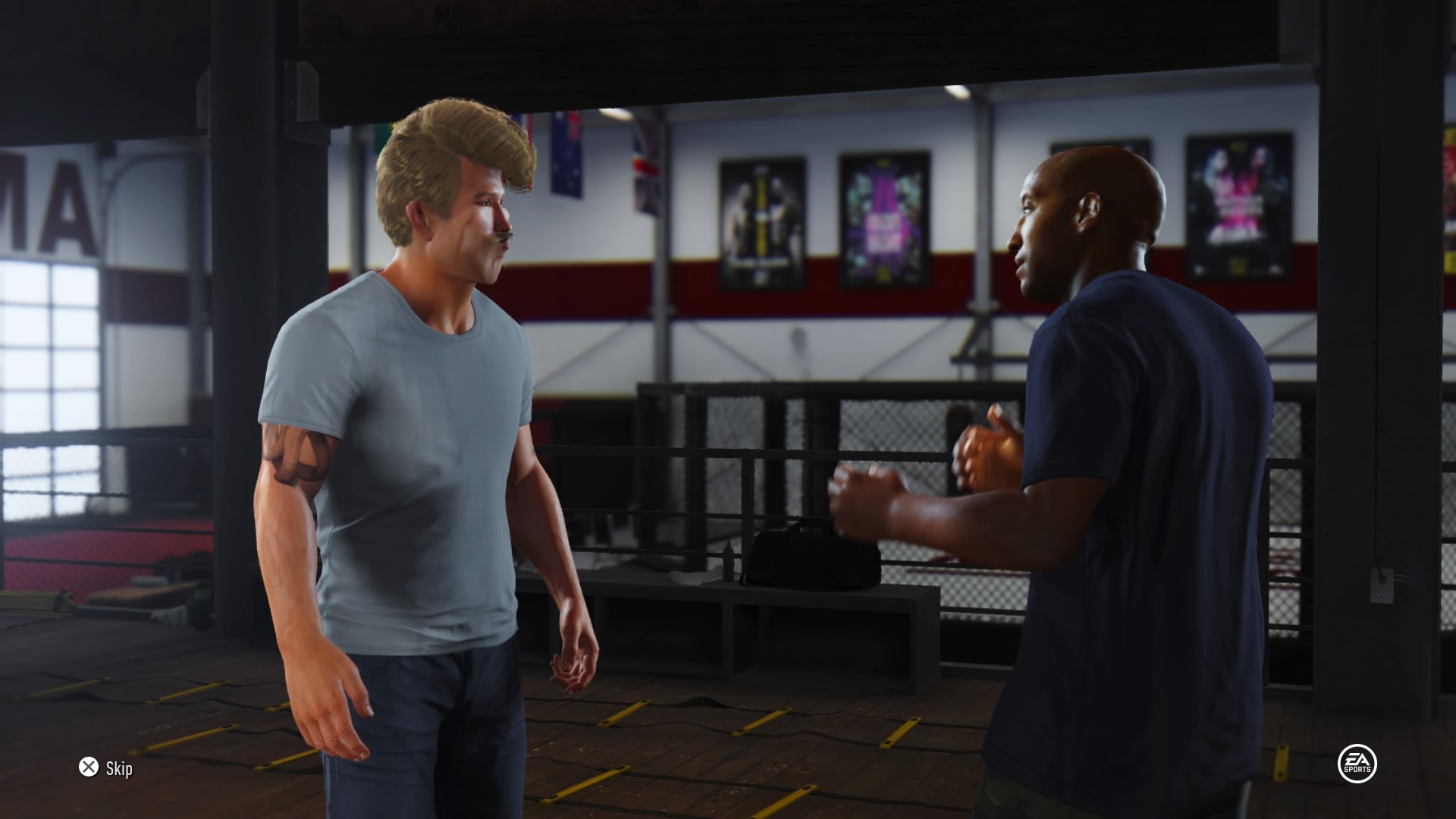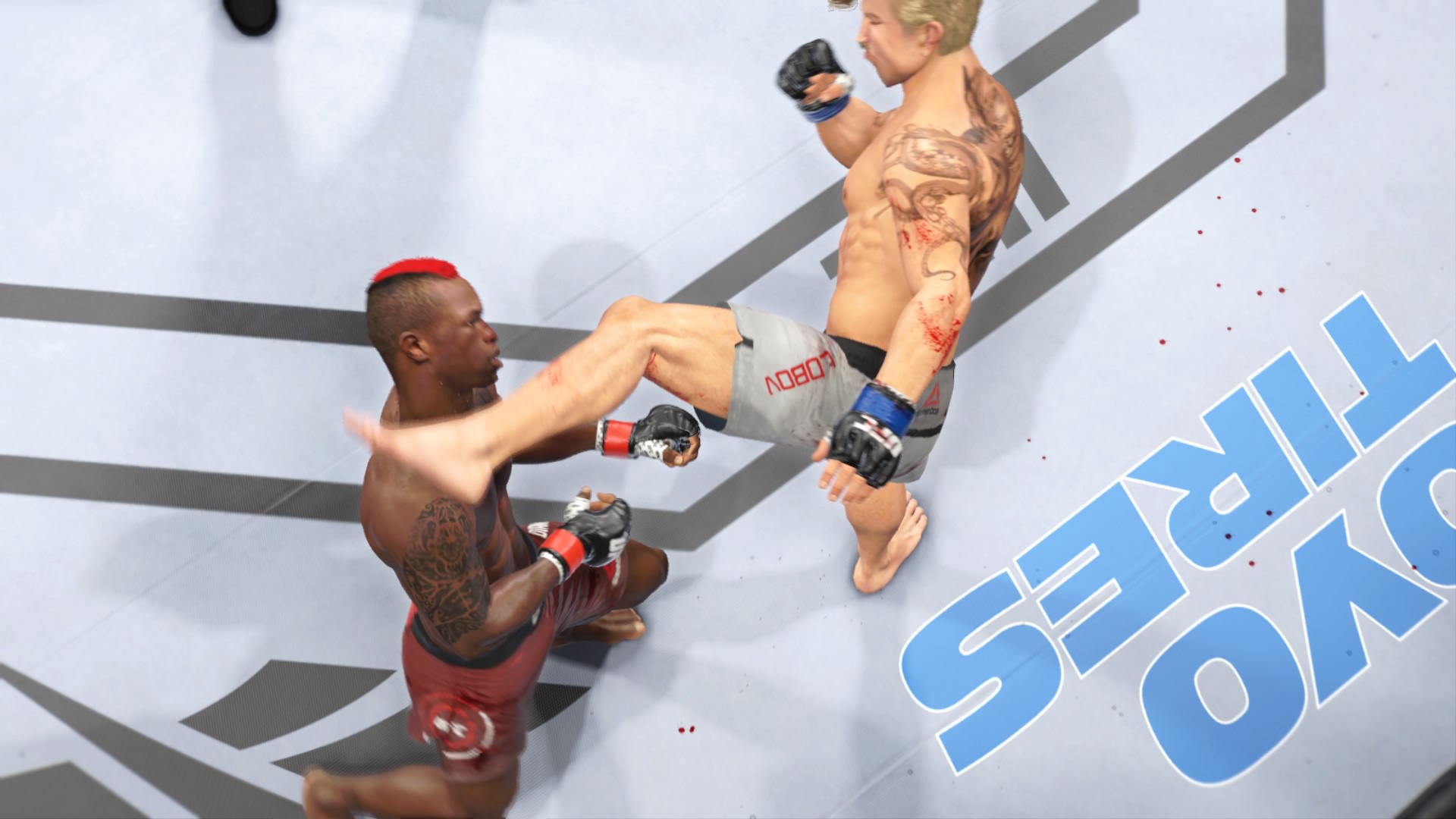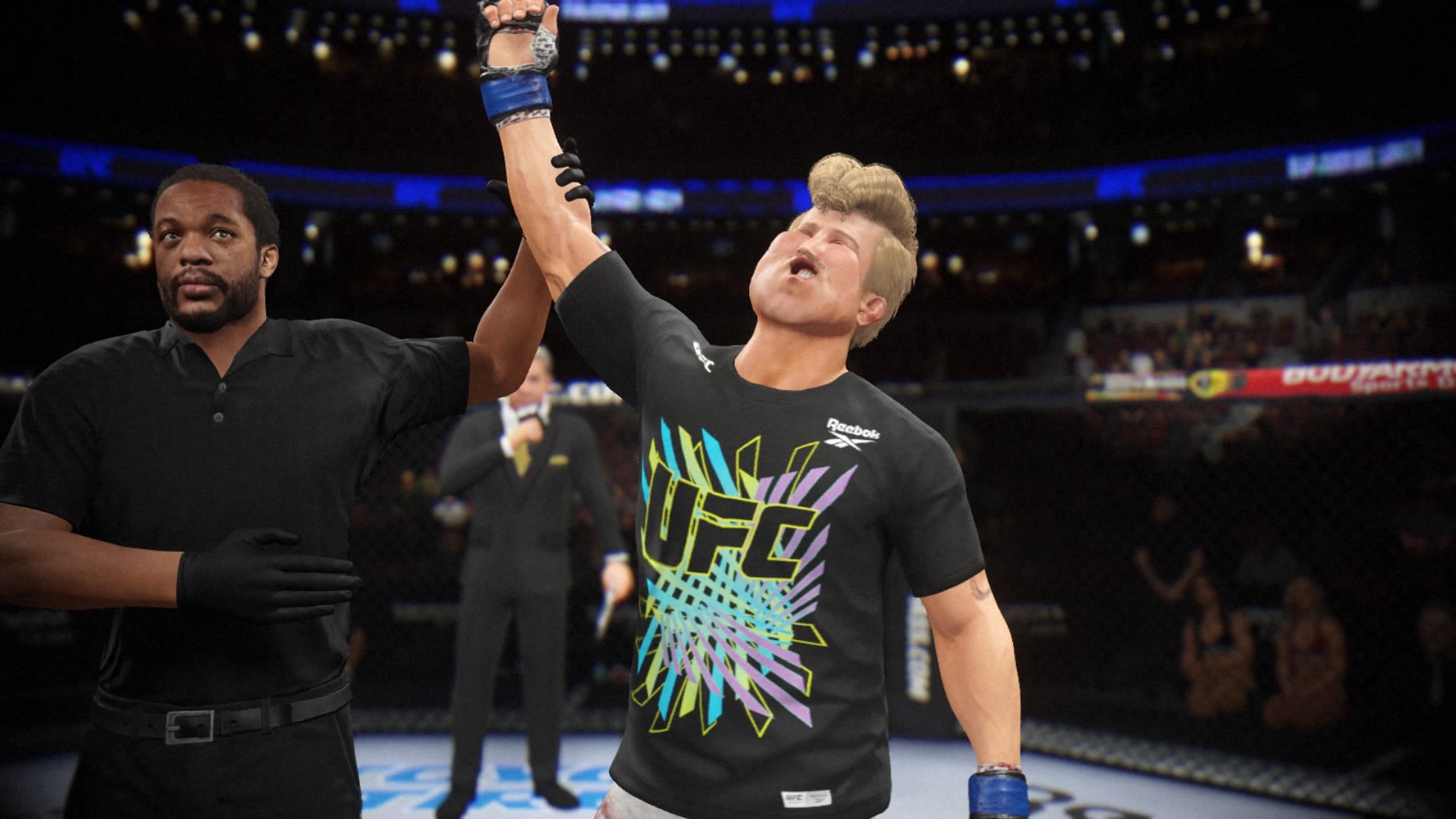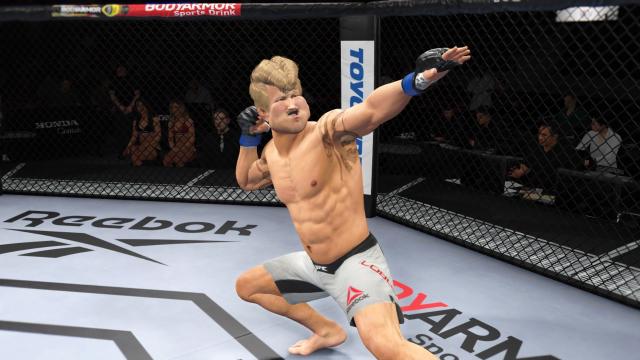Sometimes, when an MMA fighter takes a couple years off, they come back transformed, throwing out so many new looks and techniques that it’s like they spent their entire time away in an extended training montage. Other times, they’re pretty much the same as before, but a little creakier, a little rustier, and a lot more in danger of letting everybody else pass them by. EA’s latest UFC game is mostly the latter, but improvements to gameplay and slightly more willingness to engage with the realities of the UFC keep it from feeling entirely washed up.
EA Sports UFC 3 came out more than two years ago, a longer gap than is standard for EA Sports games, but par for the course with its UFC series. After multiple same-y, middle-of-the-road entries, it was hard not to hope that last week’s EA Sports UFC 4 would mark some kind of turning point. For the most part, it’s an evolution, not a revolution. Striking still feels fantastic once you acclimate to all the trigger holding and finger contorting you have to do to pull off more advanced techniques. Wrestling and submissions — now simplified, by default — still feel wonky, lacking the grace, pace, and impact of the stand up game.
Where combat is most notably improved is in the transitions between phases. While takedowns that lead to wrestling and Jiu Jitsu on the ground are more or less the same as they were in EA Sports UFC 3, the clinch game — in which two fighters tie up while on their feet and throw punches, elbows, and knees — has been overhauled. Now you can subject opponents to the sort of murder blender of knees and elbows that former UFC middleweight champion Anderson Silva once famously used to send former-er UFC middleweight champion Rich Franklin’s nose to the backside of his head. You can quickly and intuitively clinch at multiple angles, bully fighters up against the cage, and all that fun stuff. Basically, dirty boxing — in the style of just-retired ex-heavyweight champ Daniel Cormier, among many, many others — is much more viable now.
But balance is still an issue. While I’ve only played for about six hours at this point, wrestling and submissions feel too dominant so far. The newly simplified control scheme for this portion of the game — which sees you hold the left analogue stick in one of three directions depending on whether you want to try to stand up, apply a submission, or reverse position and craterize your opponent’s face — is an improvement, but the rhythm of it is still awkward. If your opponent has better wrestling stats than you, you can fill up the little circle metre that suggests you’re about to, for example, stand up, only for your opponent to repeatedly steamroll right over your input and advance position until you’re in deep trouble. This can be frustrating, especially when you’re first coming to grips with the system.
On top of that, trying to battle back against a superior wrestler drains the heck out of your stamina, the game’s most precious resource, meaning that you emerge at a severe disadvantage even if you don’t get choked out or wind up with one arm that’s suddenly a lot more pretzel-shaped than the other. Admittedly, this infuriating dynamic does sometimes play out in real-life fights. If you’ve ever watched lightweight champion Khabib Nurmagomedov ragdoll an opponent into deflated oblivion, you know what I mean. But Khabib is exemplary precisely because he can do that to people, while many other fighters cannot. Once things hit in the ground in EA Sports UFC 4, that dynamic plays out a little more often than I’d like.
There are also two different metre-based minigames depending on whether you’re applying a submission or defending against one. They’re basically the same regardless of which side of the equation you’re on — the fighter going for a submission tries to move a little rectangle on top of the defender’s, who can flee by pushing their little rectangle into other, unoccupied portions of a small space — so I’m not sure why they necessitated two different UIs and control schemes. This new system also finds itself uncomfortably sweating and grunting up against the same problem as previous UFC games: it doesn’t capture the thrill of grappling the same way that in-game striking feels akin to the real thing. In real life, grappling is a chess match punctuated by spasmodic fits of decisive action. In EA Sports UFC 4, it’s a slow trudge that just doesn’t feel very good.

But the portions of EA Sports UFC 4 that do feel good feel very, very good. Striking is by no means perfect, but it remains a satisfying game of inches in which reading your opponent and setting traps can pay dividends. Slipping your opponent’s punches and watching sweat, spit, and blood fly as you land the perfect slobber-knocker is a joy. Then again, I’ve also found that you can just completely break the striking portion of the game by pouring tons of points into punching power in the game’s career mode, but I’ve already reached a point where that strategy isn’t carrying me as far as it did early in the game.
Speaking of career mode, that’s mostly what I’ve played at this point — alongside some expositions between non-created fighters here and there — and I’ve been surprised to find myself enjoying it a fair amount. It’s really not fundamentally different from EA Sports UFC 3‘s career mode, but surprising details have kept me entertained. The basic setup is the same as ever: You’re a scrappy up-and-coming fighter with a chip on your shoulder and a dream. With the assistance of a coach who sees that You’ve Got Potential, Kid, you work your way up through amateur leagues and, after a few fights, into the UFC. From there, you try to win the championship and stack up wins and finishes until you’re declared the greatest of all time. The presentation is a glitzier version of what was on display in EA Sports UFC 3. This time, for example, your coach is a fully voiced character. So are you, actually, though your character mostly just grunts out the words “thanks” and “yeah” a lot.
As with any mode in an Ultimate Fighting Championship game, fights are the main event of career mode, but you spend much of your time between fights training. You can allocate weekly resources between simple sparring matches that improve specific techniques, studying tape on your opponent to learn their tendencies, inviting a famous fighter to come train you, and promoting your fight. The latter is, as ever, an opportunity for the sort of drama and occasional intrigue that big UFC fights cultivate these days, but mostly, you just get to make the occasional snide quip on a nameless in-game social media network to either get faceless fans excited about your fight or rile up opponents. There are cut-scenes, but while sometimes fun, they’re few and far between.
Still, it’s easier to play the heel this time around, and there’s a reputation system in which your actions in training and on social media dictate how much other fighters like you and are willing to work with you. So far, I’ve been a gargantuan piece of shit to everybody, and I’ve had a delightful time. This has been doubly enjoyable because, despite relatively limited create-a-fighter options, I’m pretty happy with the cage-fighting Frankenstein I’ve managed to craft. You might notice that his face looks like a shovel that’s been repeatedly smacked into shape by several other shovels. This is by design. My backstory for my character, Subject Six “The Gentleman” Lobov, is that he was created in the same lab as other MMA science experiments like hulking child-man Sage Northcutt and, of course, the consensus greatest fighter of all time, UFC washout Artem Lobov. But those experiments ultimately failed because they weren’t focused enough on functionality. On the other hand, Subject Six, a product of leftover Sage Northcutt DNA, has the ultimate chin. He cannot be KO-ed. Have you ever tried punching a shovel? It’s a bad time. Everything else about him is also honed for combat. Especially his pompadour.

But where Sage Northcutt is possessed with childlike naivete and kindness, Subject Six knows only the youthful proclivity for dispassionate destruction. He also recognises the fact that he is a chimera born of unethical science, thus his tattoo of a bunch of conjoined photo-realistic animals and also some tentacles. It’s been a stupid good time to run my monster baby — whose listed age is 18 because that’s the in-game minimum, but who was actually grown in a tube just three months ago — up the ranks. I am very much making my own fun here, but the game’s systems have facilitated it. Not only have I been picking the mean dialogue options, but I’ve also found surprising ways to revel in classless douchebaggery. I’ve knocked out multiple sparring partners, which leaves them injured for weeks and removes my ability to engage in whichever variety of training they specialise in. I’ve also knocked out fighters I invited to my gym for the purpose of helping me learn. On one occasion, I absolutely flatlined lightweight contender and part-time UFC commentator Paul “The Irish Dragon” Felder, at which point the game asked me if I wanted to be honorable and dispose of the gym footage of our encounter or keep it in case he and I ever face off for real. I kept it, obviously.
While EA Sports UFC 3 tried really hard to pretend that MMA — at least, under the UFC’s stewardship — is a button-down sport rather than a circus where all the clowns either are or were at some point on steroids and the people running the show are domineering bile sacks who have no problem vastly underpaying fighters and cozying up to countries guilty of horrific human rights abuses, EA Sports UFC 4 engages the tiniest, barest-minimum bit with MMA’s less savoury side. But obviously, because it is a licensed product, it cannot comment on the ugly realities of those very real facets of the fight game. In career mode, you can decline fights, but if you decline too many, you risk pissing off the promoter, aka UFC president Dana White. This is a real-life dynamic, and White has a habit of publicly insulting fighters who ask for better treatment or replacing them with folks who are willing to take bottom-of-the-barrel pay. In EA Sports UFC 4, it’s just a game mechanic.
Similarly, there are optional contract bonuses in the game. One stipulates that you must take every fight the promoter hands you — no ifs, ands, or buts — for a certain number of fights. Basically, you’re being a Company Guy, but also potentially missing out on big fights in pursuit of a larger payday down the line. In the game, that payday is guaranteed. In the real UFC, many fighters attempt this, but then they fail to live up to expectations or decide they deserve better, and the organisation either shelves them until they’re desperate for pay or boots them entirely.

It is odd to see these dynamics masquerading as easygoing gameplay mechanics when they’re actually incredibly pernicious elements of real-life combat sports — to the point that the UFC has spent years dealing with an antitrust lawsuit in part over the way it treats its fighters. But I suppose that feeling comes part and parcel with consuming any portion of the UFC’s Hydra-like product these days: Unless you close your eyes and pretend that severely underpaid people aren’t bleeding for your entertainment, it’s hard to feel entirely good about it.
At least the people in EA Sports UFC 4 are not real. Once again, this series portrays a fantastical version of MMA that’s fun — even exhilarating, at times — if you turn your brain off, but by straddling the line between what the UFC actually is and the kinder, more orderly thing it wants the world to see it as, the game winds up in no man’s land. If nothing else, the latest instalment takes some steps in the right direction, even if it still hasn’t cracked the code on grappling and it can’t decide if the UFC is “sports” or its more dramatic, over-the-top cousin, “sports entertainment.” Perhaps EA Sports UFC 5 will finally get it right. Then again, that’s exactly what I said about EA Sports UFC 4.

Leave a Reply